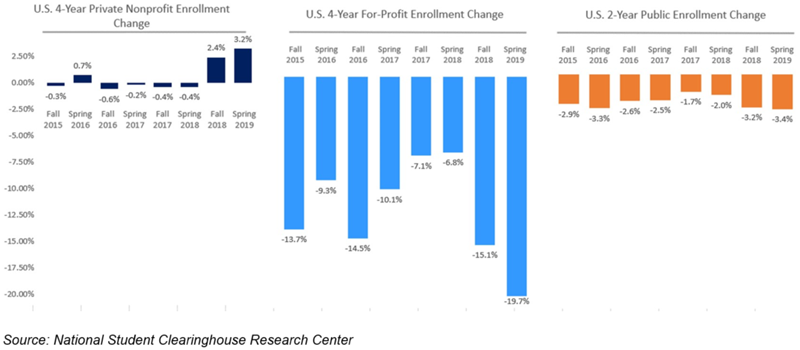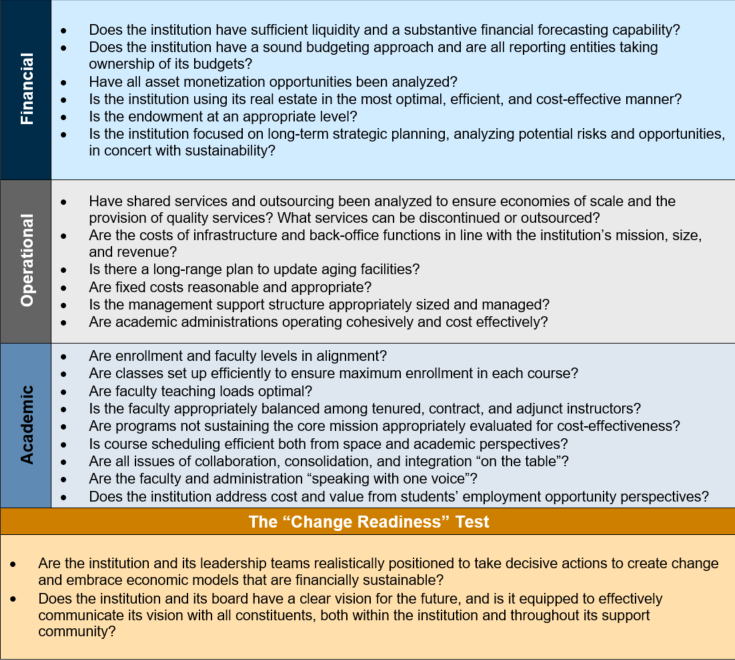Restructuring Perspectives for Higher Learning
February 12, 2020
Introduction
In recent years, as affordability continues to be a more sensitive focus, high school seniors and their families have become increasingly skeptical about the relative value of the traditional four-year college experience. Historically, a seemingly unlimited number of prospective students enrolled in ever-expanding programs, sustained by federal research grants and state government funding. The landscape has undergone dramatic change, and institutions of higher learning across the country now acknowledge they must perform in a significantly more competitive market, imbued with academic, financial, and operational constraints. While each school has its particular issues, all schools must engage in ongoing evaluation of its strategies to address these constraints.
The new reality is that costs, alternative revenue streams, and student enrollment have shifted—all in an unfavorable direction—applying significant pressure on academic boards and management teams, who now must take necessary actions to pursue long-term sustainability. To remain viable, U.S. colleges and universities must adapt by implementing sustainable financial, operational, and academic models; thus, remaining viable and equipped to fulfill their missions. Internal auditors within institutions of higher education must be aware of the challenges and options available to colleges and universities to remain viable so that they can better assess risks and provide continued valuable audit and advisory services.
Financial Challenges Facing Higher Education
Financial sustainability is arguably the greatest challenge threatening U.S. colleges and universities.
Financial sustainability is arguably the greatest challenge threatening U.S. colleges and universities. Nearly all funding sources have tightened and most schools are simply spending more than they can afford. Colleges and universities also require updated operational and academic strategies, coordinated with financial responsibility, to sustain their core mission. Cutting costs and increasing revenue will likely fail to achieve true sustainability if they are not tied to strategies closely aligned with the institution’s mission.
A significant challenge facing public higher education institutions in the U.S. is that state funding declined by an inflation-adjusted 13% between 2008 and 2018, falling to an average state spend per student of approximately $1,200. Of the 41 U.S. states that reduced funding for higher education during the last decade, 19 states made cuts of more than 20%, and six made cuts of 30% or more. Private universities face similar levels of financial stress as competition among schools intensifies with higher cost structures.
To address net cash challenges, many colleges and universities increased tuition substantially, resulting in an overall decline in U.S. college and university enrollment. Between 2011 and 2016, enrollment in U.S. institutions dropped 7.8% from 20.6 million to 19 million and fell to 17.3 million in the spring of 2019. Four-year for-profit institutions experienced the greatest decline compared to two-year public institutions and four-year private non-profits (Exhibit 1). Declining enrollment is expected to continue through at least 2030, pressuring colleges and universities to compete more fiercely for students.
Exhibit 1
Year-Over-Year Enrollment Changes in U.S. Colleges and Universities (Fall 2015–Spring 2019)

This drop-off is particularly steep for low-income, high school graduates. Simultaneously, international student enrollment—a significant source of tuition income for many U.S. institutions—has also been declining due to immigration concerns and rising competition from other nations. The 2018 OpenDoors Survey conducted by the Institute of International Education indicates that 49% of responding institutions reported a decline in international enrollment applications for Fall 2018.[1] Declining international enrollment could have a significant impact on the financial models of U.S. colleges and universities, with potential losses of at least $250 million in tuition revenue annually.
Institutions need to not only demonstrate clear value to students internally, they also need to structure their financial, operational, and academic models to maximize resources and attract students, while attempting to remain viable in the short term and sustainable over the long term.
The combination of rising tuition, deeper debt burdens, and an increasingly competitive job market is fueling greater scrutiny by students and their families when it comes to assessing the value of a college degree. Today’s students expect lower tuition, while at the same time demanding improved services and campus infrastructure, and demonstrable post-graduation employment opportunities—making the landscape significantly more competitive for U.S. colleges and universities. Institutions need to not only demonstrate clear value to students internally, they also need to structure their financial, operational, and academic models to maximize resources and attract students, while attempting to remain viable in the short-term and sustainable over the long-term.
Sustainable Solutions for Higher Education
All schools are affected in some way by the economic, political, and financial changes of the last decade. For too many colleges and universities, balance sheets and income statements are trending negatively. To remain sustainable, boards and management teams need to contain tuition, increase affordability, and broaden access through all of the following:
- Diversifying funding sources to address revenue shortfalls
- Investing in, and applying, appropriate resources to the core business
- Creating multi-faceted, cost-efficient financial, operating, and academic models that appropriately align costs while preserving the core mission
- Offering a clear value proposition to students and stakeholders and aligning programs with student demands
- Ensuring all constituents (e.g., board, administration, and faculty) embrace the need for change and the urgent need for sustainability, and are resolved to implement difficult changes
- Having the conviction and resolve to make the difficult decisions and implement the necessary changes
U.S. colleges and universities cannot rely as heavily on state and federal funding as they have in the past. Aside from raising tuition—an option which may be maxed out given significant increases in cost and the decline in student enrollment—other material funding options include online learning programs, fundraising, creative asset and infrastructure monetization, and taking on prudent levels of additional debt.
To keep revenue growth above expense growth and to ensure prudent financial management to deal with future unknowns, many institutions should rethink their business models, and ask themselves tough questions like those outlined in Exhibit 2.
Exhibit 2
Illustrative Questions for Assessing an Institution’s Sustainability

By taking a hard look at these areas and ensuring that operational and academic structures are right-sized based on the institution’s volume, revenue, and mission, colleges and universities will not only achieve greater efficiency, they will also be able to better demonstrate value to students and stakeholders.
Even the strongest colleges and universities must acknowledge the need for change, plan for a less favorable revenue environment, and implement necessary financial strategies. Failure to do so, or postponing until tomorrow what must be done today, will ultimately put a sustainable mission at risk.
To maintain an institution’s viability, it is the responsibility of an institution’s board, management team, and faculty to:
- Ensure reliable levels of liquidity with clear strategies that align with the core mission
- Strengthen the institution’s financial statements with the overall objective of long-term sustainability
- Focus on and strengthen the core characteristics of the institution to differentiate the school from its competition
- Demonstrate detailed academic programming to fulfill the school’s mission with enhanced scrutiny on academic quality and integrity, buttressed by cost-effective faculties, class programming, and academic support centers (remain open to divesting from assets, activities, and programs that are non-core)
- Right-size operational support and shared services teams with a focus on quality and efficiency
- Optimize the use of all fixed assets and explore appropriate opportunities for asset monetization
- Align academia with a sustainable business model
- Find common ground among the administration and faculty to make the necessary transformation while protecting the mission and core business
- Demonstrate to prospective students that the institution’s programs and experiences are of meaningful value
Each institution’s board of trustees must hold management, executives, and faculty accountable for maintaining efficient financial and operating models to provide true academic value to students.
Conclusion
The colleges and universities that rise above the challenging forecasts for the higher education sector will be those that are willing to openly evaluate financial, operational, and academic business models to adapt and embrace sustainable strategies supporting these models. To accomplish this, each school must have administrative and academic leadership on the same page, developing well-defined, thoughtful strategies across the entire institution to implement a revitalized vision and path for long-term sustainability.
[1] https://www.iie.org/en/Research-and-Insights/Publications/Fall-2018-International-Student-Enrollment-Hot-Topics-Survey
About the Author

Robert Hershan
Robert is a Managing Director with A&M’s Turnaround and Restructuring practice. With substantive commercial and legal expertise, he has significant experience managing complex transactions.
Read Full Author Bio

Robert Hershan
Robert is a Managing Director with A&M’s Turnaround and Restructuring practice. With substantive commercial and legal expertise, he has significant experience managing complex transactions.
Articles
Restructuring Perspectives for Higher Learning